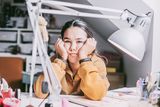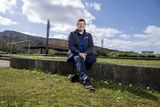Master of the dark art: Gottfried Helnwein on how his country’s dark past led to his career and life in a Tipperary castle
Austrian-born artist Gottfried Helnwein talks to Dónal Lynch about how his country's dark past led to his career, his life in a Tipperary castle, the magic of Irish pub culture and befriending Marlene Dietrich
Over a humpback bridge, past a religious grotto, down a rain-swept driveway, Gurteen Castle looms in the mist. A huge Gothic door, embossed with metal and wood, creaks open and inside Gottfried Helnwein is waiting, dressed all in black, with shades and a bandana decorated with pentagrams.
With a hand weighed down with skull rings he beckons me inside, where candlelit corridors lead to grand rooms filled with his paintings: a disturbing 20ft-high take on the nativity, with Hitler as baby Jesus, surrounded by SS wise men; a sinister figure wearing a plague mask, about to ravish a dreaming body; luminously beautiful girls with blood smeared across their faces.
Upstairs is a room filled with files of Gottfried's photo sessions with eclectic and famous figures: Michael Jackson, Andy Warhol, Leni Riefenstahl. And out the back is the artist's studio, a rectangular room, with walls lined with priceless etchings and scattered here and there with skulls, alchemical paraphernalia ("my mystical substances") and comic books. It's all demented, dark and utterly beautiful.
After this grand tour like no other, I take a seat by a roaring log fire in the main drawing room and Gottfried tells me how he came to live in rural Tipperary.
Artist Gottfried Helnwein with wife Renate at Gurteen Castle. Photo: David Conachy
"I had been based in LA for years but I never really fit in there, I am too European," he begins in a strong Austrian accent. "First, I wanted to go to Italy which was to me the best place in Europe but I couldn't take it, everyone's bribing everyone and it's great, it's worked for 2,500 years, but it's not for me. And so we decided to try Ireland about which I knew nothing at that point.
"At Christmas. 24 years ago. I drove with my family to the west coast. It was snowing and everyone was at home. We ended up in a little hotel with a peat fire and we all said 'this is the best country, we love it here'. Ireland is nothing special economically or militarily but its cultural influence has been wildly disproportionate and it seemed like a magical place to me. We got an apartment on Parliament Street in Dublin and I said to my wife, 'please find me a castle' and she is a great person for finding things, she goes on a mission."
Gurteen, a 40-room Elizabethan revival castle was built in 1866 for Pope Pius IX's chamberlain, Edmund de la Poer, and came from the same designer, Samuel Usher Roberts, who worked on Kylemore Abbey. It's a fitting residence for a man whose work has been wildly praised by figures as diverse as William S Burroughs and Sean Penn. Gottfried and his elegant wife, Renate, have restored it to (and, you suspect, beyond) its former glory. It's the type of place where you could imagine the eyes of the portraits following you across the room.
In 2005, Marilyn Manson got married to Dita Von Teese at the castle - the wedding was officiated by the surrealist filmmaker Alejandro Jodorowsky. When the bathroom collapsed as Von Teese was about to take a bath before the ceremony, she barely escaped with her life. Later, at dinner, Gottfried tells me, he blithely told the guests that it had merely been one of the castle's ghosts who was "jealous" of the bride, in her purple Vivienne Westwood wedding dress.
Yet, despite its Gothic arches, mischievous spirits and grand provenance, Gurteen is also what the Austrians would call gemütlich (roughly: homely) and there is a gentle warmth in the Helnwein household that belies the eccentric appearances. As Gottfried and I discuss Rembrandt, a small dog insistently taps my foot with a ball, urging me to play fetch. A grandson approaches my partner, who is waiting in an adjacent room, and hands him a piece of paper. "It's a flyer," the little boy explains. "For my performance of my song, 'Coward'. Will you be here at 7pm?"
When we explain that by then we will have left for the tedious reality outside the castle gates, the little boy silently proffers one of his comics, and he and my partner settle in to read, side-by-side.
Gottfried at home in his studio. Photo: David Conachy
Gottfried's own early life was light years from this idyll of childhood. He was born just after World War II in Vienna. His father worked as an official in the postal service.
"I knew something was not right. Vienna was a dark place, it felt like being born into hell because every grown-up was aggressive or grouchy or depressed," he says. "There were no children's books, no movies at the beginning, even. What I didn't understand at that point was that my parents' generation had just lost the second world war in a row and had participated in the greatest genocide in human history."
He recalls a moment from his teen years when the Holocaust perpetrator, Franz Murer, aka The Butcher of Vilnius, was put on trial in the city of Graz. "I read the horrible details of the people he had tortured and killed and it was the first time I heard about the Holocaust. Witnesses had come from Israel and had nervous breakdowns and cried. And yet there were people at the court still doing Hitler salutes. Murer was acquitted and all of the flower shops in the city of Graz were empty because everyone had brought flowers to celebrate. And this was the moment I disconnected from my parents' generation."
At 18, he moved away from home and into a rented attic. "There was a moment that year when I thought 'the only thing left is to become an artist'. Me and my friends never cared about money. We were sitting in coffee houses all day. It was wild, a lot of drinking. People seemed insane, free. It all was a reaction to the older generation."
He studied at Vienna's University of Visual Art (the very same institution that had rejected a prospective student named Adolf Hitler some 50 years previously).
From the very beginning, the theme of innocence corrupted preoccupied him. "Violence and sadism toward the defenceless, especially the abuse and torture of children, were always on my mind. I researched and saw forensic photographs of children who had been killed. I read about the abuses the Americans perpetrated in Vietnam. I was obsessed with fairness and justice, but nobody else cared about that. People of my age were just talking about f**king women."
Dita von Teese at her wedding in Gurteen. Photo: Mary Mulqueen
Throughout history, most art had depicted children as serene, but Helnwein's early work featured little girls, blood spattered or with deformed faces. They represented innocence corrupted.
"The image of the wounded child has always been central to my work," he says. "Every human being is once in life a child. You can see an enormous potential, they have unlimited imagination and then they lose it through the education system, the brutality of the world."
In Austria, he used the same child model again and again, a girl called Sandra. Often she was blindfolded, an apparent symbol of repression, and Helnwein was enchanted with her dignity and independence.
"She was so tough and mean. I saw someone who is not broken, nobody messes with her. I asked her what she wanted to participate in an art project and she said 'I want a bicycle'. I photographed her on the street and inserted instruments in her mouth but I was always careful not to hurt her."
Later he did a series of self portraits, including one of himself as a "subhuman" - the Nazi designation for gypsies, Jews and gay people - and held an exhibition in Cologne in remembrance of Kristallnacht ("the night of the broken glass" - a pogrom carried out against Jews in Germany before World War II).
The nightmarish themes of his work caused outrage amongst a public still reluctant to face up to its past. One of his first exhibitions was shut down early by the gallerist, following protests by journalists, and his work was labelled "entartete Kunst" (German for degenerate art), a description that, ironically, had also been used in the Nazi era.
"I was always an outsider, but I was comfortable with that," he says. "I really believe that if art is not about protest and outcry, then it's crap and bourgeois."
Latterly, he has assumed a kind of respectability - in 2015, a retrospective at Vienna's Albertina Museum was the most successful ever by a living artist. In America, his show in San Francisco carried an age warning but the exhibition provoked a huge and cathartic outpouring of emotion in those who saw it.
He says that he is largely ignored by the bankers and investors who manipulate the art market but he certainly has his share of celebrity fans. Sean Penn says Helnwein is "as great a living artist as we have today" and his and Renate's friends have included Lou Reed and the late, great Marlene Dietrich.
"During her last 10 years, we were in constant contact with her," he says. "Maximilian Schell made a movie about her called Marlene (1984) and they asked me to do the movie poster for that. We got in contact with her and she told us lots of personal stories. I said to her, 'you were so brave to reject the offers of the Nazis' [Hitler's propaganda minister, Joseph Goebbels, had offered Dietrich millions to return to Germany from America] and she said, 'Ach, it wasn't political, I don't care about politics, I just hated the way they were treating my Jewish friends, it was an easy choice. You can't work with people like that'.
"She lived in Paris at that time and she didn't have much money and she lived in seclusion. She had to let her assistant go and when she answered the phone to us she would pretend to be the assistant. She was a terrific gossip. When [Greta] Garbo died, [Dietrich] told me, 'the media are not saying how she died; it was really uric poisoning. They don't think this fits the image of how a screen goddess should go'."
Gottfried met his wife Renate in the 1970s. "I was working as a trained nurse and had also worked at psychiatric wards where I saw a lot of brutal treatments, like ECT [Electric Shock Therapy] and lots of drugs to keep the patients quiet," she says. "There was just a lot of suppression and very little respect for the people. I felt it was a very inhuman way to treat people the way they did. I had a lot of objections. You can't treat any human being the way they did."
In 1975, she saw a small reproduction of one of Gottfried's paintings 'The Intrusion', which depicted a child strapped down to a table having a big metal tube forced into her mouth.
"I felt instantly connected and decided to meet the artist. I felt that he knows what's going on and he is looking under the carpet. This painting showed exactly the type of thing they do in psychiatric hospitals and what I have seen with my own eyes, just with different means. When I saw this image, I knew that this artist has a strong message and that he is fighting with his art against suppression and manipulation."
She travelled to Vienna and met Gottfried and "since that time, we are on the same track".
They did not insist their children go to school ("I said to them, 'I'm a grown up, I can sign anything'," Gottfried tells me) and, eventually, they homeschooled them. Certainly, their creativity has been passed on to the next generation. Their daughter Mercedes (41) is a renowned artist and novelist in her own right - one of her exhibitions was bought, in its entirety, by Damien Hirst. Ali (38) is a Grammy and Emmy-winning composer who lives in LA. The youngest Amadeus (34) works at UCC. Cyril's wife Kojii is a musician, actress and model - she has appeared in Vogue and walked on the runway for Prada and Jimmy Choo.
"I am proud of them, of course. When I was a child myself, I was outraged by how I was treated," Gottfried says. "I thought 'I'm somebody' but I was treated like a little idiot. So when I became a father, I didn't want my own children to feel like this. I don't want to be their senior, I want to be their ally."
The children grew up with a flock of ducks in the grounds of the castle. The birds are a nod to Gottfried's lifelong obsession with Donald Duck, a recurring motif in his work, but they were also pets.
"We had a housekeeper once who said 'what about duck for dinner tonight' and the children were horrified," Gottfried says, laughing. "They didn't even know you eat duck!"
After nearly a quarter of a century in Ireland, they are well settled and are an integral part of the community in Kilsheelan, a town of roughly 500 people in Co Tipperary.
"My wife knows all the country pubs and all the different dances and jigs," Gottfried says. "She also started to play Irish music, and my daughter plays the banjo. That was something that impressed me so much about this country, if you go to the country pubs, it's magical. People from young to old come and there are no tourists. They start to play and jam, or there's a storyteller or kids that dance. Irish people tell me, 'we know a different Ireland' but this one I am describing does exist. We have a party every summer with musicians and they can play classical music and blues and they dance the whole night. You might meet an old farmer, with hands like shovels, and you think what can he do with this violin? But then he plays so beautifully."
He says that the closure of the pubs during the pandemic will be "a particular disaster for Ireland. It's a destruction of a central part of the culture."
At times, the overtly provocative nature of his art has rubbed up against bourgeois Irish sensibilities. In 2001 a former mayor of Kilkenny, Paul Cuddihy, objected to a proposal to display one of Gottfried's paintings, 'Epiphany II', at Kilkenny Castle. In the painting, which was based on a Nazi propaganda poster, Hitler's image is replaced by that of the Virgin Mary holding the infant Jesus. After visiting Gurteen, however, Cuddihy was convinced of Gottfried's bona fides and the former Kilkenny arts festival director (and current director of the Arts Council) Maureen Kennelly said that the artist was clearly "very moral".
In 2008, vandals attacked a billboard depicting his work in Waterford, which had provoked objections from some locals. Gottfried brushed off the vandalism and criticism, saying, "If you put your work in public space, then of course you have to take responsibility for the consequences. People have the right to respond and react."
Now 72, he continues to work. A polymath, he spends his days reading history and literature ("which is the real history of humanity") and wealth and success have not brought complacency.
The issues he explores in his paintings, far from having been resolved, are more pressing than ever, he says. In his youth, he ignored the history of art but now, in old age, and, like Caravaggio, whom he numbers among his influences, his work continues to display an electric combination of fury and compassion.
"The image can reach a level that you cannot reach by any other means. It can touch something deep inside the person. Marcel Duchamp said art is a bipolar product, 50pc is the artist, 50pc is the viewer. My partners are the people who view my work, without them it would be a very lonely business."
Outside, the Baskerville gloom is gathering, and ghosts and grandchildren are preparing for their evening performance. It's time to leave Gurteen.
Gottfried and Renate graciously see us off at the door, impeccable hosts to the end. We are in a daze, reeling from the overload of Nazis, nightmares and corrupted waifs. And it seems that, in one unforgettable afternoon, this eccentric and brilliant family has given us sensory sustenance for the long weeks to come.
Join the Irish Independent WhatsApp channel
Stay up to date with all the latest news














